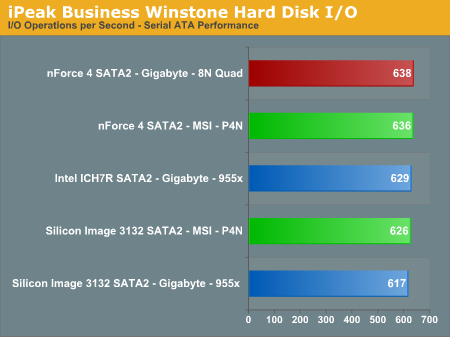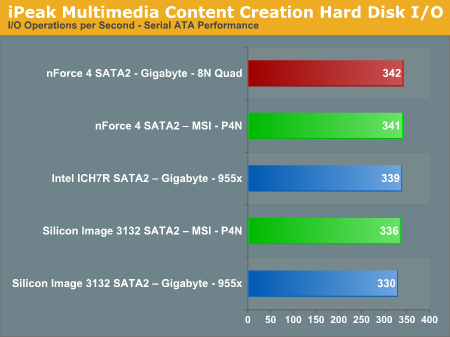Intel Motherboards: Something Wicked This Way Comes...
by Gary Key on October 12, 2005 2:13 PM EST- Posted in
- Motherboards
Disk Controller Performance
With the variety of disk drive benchmarks available, we needed a means of comparing the true performance of the wide selection of controllers. The logical choice was Anand's storage benchmark first described in Q2 2004 Desktop Hard Drive Comparison: WD Raptor vs. the World. To refresh your memory, the iPeak test was designed to measure "pure" hard disk performance, and in this case, we kept the hard drive as consistent as possible while varying the hard drive controller. The idea is to measure the performance of a hard drive controller with a consistent hard drive.
We played back Anand's raw files that recorded I/O operations when running a real world benchmark - the entire Winstone 2004 suite. Intel's iPEAK utility was then used to play back the trace file of all IO operations that took place during a single run of Business Winstone 2004 and MCC Winstone 2004. To try to isolate performance difference to the controllers that we were testing, we used the Maxtor MaXLine III 7L300S0 300GB 7200 RPM SATA drive in all tests. The drive was formatted before each test run and a composite average of 5 tests on each controller interface was tabulated in order to ensure consistency in the benchmark.
iPeak gives a mean service time in milliseconds; in other words, the average time that each drive took to fulfill each IO operation. In order to make the data more understandable, we report the scores as an average number of IO operations per second so that higher scores translate into better performance. This number is meaningless as far as hard disk performance is concerned as it is just the number of IO operations completed in a second. However, the scores are useful for comparing "pure" performance of the storage controllers in this case.
With the variety of disk drive benchmarks available, we needed a means of comparing the true performance of the wide selection of controllers. The logical choice was Anand's storage benchmark first described in Q2 2004 Desktop Hard Drive Comparison: WD Raptor vs. the World. To refresh your memory, the iPeak test was designed to measure "pure" hard disk performance, and in this case, we kept the hard drive as consistent as possible while varying the hard drive controller. The idea is to measure the performance of a hard drive controller with a consistent hard drive.
We played back Anand's raw files that recorded I/O operations when running a real world benchmark - the entire Winstone 2004 suite. Intel's iPEAK utility was then used to play back the trace file of all IO operations that took place during a single run of Business Winstone 2004 and MCC Winstone 2004. To try to isolate performance difference to the controllers that we were testing, we used the Maxtor MaXLine III 7L300S0 300GB 7200 RPM SATA drive in all tests. The drive was formatted before each test run and a composite average of 5 tests on each controller interface was tabulated in order to ensure consistency in the benchmark.
iPeak gives a mean service time in milliseconds; in other words, the average time that each drive took to fulfill each IO operation. In order to make the data more understandable, we report the scores as an average number of IO operations per second so that higher scores translate into better performance. This number is meaningless as far as hard disk performance is concerned as it is just the number of IO operations completed in a second. However, the scores are useful for comparing "pure" performance of the storage controllers in this case.












44 Comments
View All Comments
DrMrLordX - Thursday, October 13, 2005 - link
Fine, I'll retract my statement, at least partially. I wasn't reading the statement carefully enough.Having looked into the newer 3D1-68GT, it seems to be a more solid product than the original 3D1 card based on 6600s. The original seemed to serve no purpose whatsoever.
Calin - Thursday, October 13, 2005 - link
They made it an Intel board assuming that the more "corporate-oriented" users prefer multiple monitors. I don't know about current performance, but in the recent past, Intel processors smoked the Athlon64 at things like Photoshop. And introduction of dual core processors at prices much lower than AMD's dual core could coax someone into buying such a board.I agree that most every normal person would be happy with four processors (powered by two cards), however I remember cases (in Linux) when OpenGL performace fell at half when enabling 2 monitor support on a single video card. This is driving a single monitor, not two. Driving two monitors, it fell even lower.
So, for every person that WANTS (not that it really really would need) four monitor output from four video cards, this looks like the best choice
trooper11 - Thursday, October 13, 2005 - link
I kind of doubt that since the cost in video equipment does not make this a low cost solution. if a company is willing to shell out for that, they would be willing to shell out for the best in workstation performance, which just happens to be the X2s
ElJefe - Wednesday, October 12, 2005 - link
ever wonder what crack they were smoking though making it an Intel board?if you read about modders and gamers , almost 80%+ market share for DIY builders use AMD.
this board is a waste of technology.
still cool though.
Gary Key - Thursday, October 13, 2005 - link
Hi,The ability to produce this board was due to Nvidia's decision to use a HyperTransport link for the Intel SLI chipset due to the need to have an on-chip memory controller. While it would be feasible to complete a AMD version of the board, the engineering time and product cost would not be acceptable. While I will agree with everyone that the current AMD processor line up offers significantly more performance than Intels, the actual day to day real life experience with both systems is not readily apparent to most people. In fact, I have had people play on my FX55 machine and 840EE machine and nobody could decide clearly which system had the AMD64 in it without benchmarks. This was at both 1280x1024 and 1600x1200 resolutions. While I personally favor AMD for most performance oriented setups, there are some people that still want Intel. After not having an Intel based machine for the last two plus years I have to admit is not as bad as most people make it out to be.
Johnmcl7 - Wednesday, October 12, 2005 - link
Whether you like it or not, the 3D1 was an innovative product, it's not childspplay to stuff both cores together and develop the motherboard support for it.John
Viper20220k - Wednesday, October 12, 2005 - link
Yeah, what is up with that.. I would sure like to know also.Wesley Fink - Wednesday, October 12, 2005 - link
The pictures of the 10-monitor display were supplied, but Gary did hook up every monitor we could, which was 8 if I recall, to test the outputs. To test 10, we needed two more Rev. 2 3D1 cards - our extra pair were Rev. 1 cards - which couldn't be here in time for a review.We did verify the ability of the individual 3D1 cards to do what Gigabyte claimed, so there is no reason at all to doubt the 10 claim. One of the key Engineers at Gigabyte works exclusively with AT and THG. All sites use some pictures and diagrams from press kits to save time, but we perform and report our own test results and analysis.
Yes, we dis ALL of the testing ourselves. Our review took longer because we did much more extensive testing of the board, including quite a bit of overclocking tests to make sure the nVidia dual-core issue we reported in our last Intel SLI review is now fixed in this chipset.
Gary spent countless hours sniffing out the good and the not so good on this board. We also found the OC capabilities of the shipping BIOS not too exciting, and we wanted to bring you the much improved OC results from the revised BIOS.
johnsonx - Wednesday, October 12, 2005 - link
Wesley,I don't think most of your readers actually thought what the subject line of this thread implies. There are always a few who like to throw stones of course.
In my read of the THG article a few days ago, I found myself thinking that the 10-display shot was from Gigabyte, as they had no detail shots of the display control panel for 10 monitors; nine was the most they were able to get working.
Like you, I have little doubt that 10 displays will in fact work with this board, but the 9th and 10th would have to come from either a PCI card or a PCIe card running in a x1 slot. Even x1 PCIe is faster than crusty old PCI, but it's still hardly ideal. It'd be nice if 3D1 cards could be coaxed into working in x8 slots (so that'd be 4 PCIe lanes per core - still plenty), as then you could theoretically have 4 3D1 cards for 16(!) displays.
Thanks for the information on how you did the review testing.
Regards,
Dave
AmberClad - Wednesday, October 12, 2005 - link
April Fool's Day already?!